|
This
story begins with C.K. Prahalad. Since the late 1990s, the management
guru has been speaking of something he calls the bottom of the
pyramid (his recent book is titled The Fortune At The Bottom Of
The Pyramid), a reference to the large number of people in the
lower economic strata, people usually ignored by companies seeking
to target the middle- or upper-classes. Prahalad's hypothesis
about companies being able to make money, and lots of it, if they
only know how to address this huge untapped market segment has
struck a chord in India. Maybe it is because he himself is an
Indian. Maybe it is because there are an estimated 500-700 million
Indians residing in what Prahalad calls the bottom of the pyramid.
In 2001, this magazine featured an article
on this theme (Selling To The Poor Profitably, Business Today,
June 21, 2001). Since then, the inclusion revolution has gathered
momentum. It still remains work in progress but now encompasses
products such as rain gauges with inbuilt data storage capabilities,
finance for low-cost housing, budget hotels, low-cost internet
access devices, even automated teller machines. Not all companies
are addressing the very bottom of the consumer pyramid, but each
is moving aggressively to capture markets hitherto unaddressed
by its offerings. Some of the stories in the pages that follow
are not new (which is a good thing because it means they have
emerged as sustainable and scalable solutions to tapping b-o-p,
bottom of the pyramid, markets). Others are. And may their tribe
increase.
The Doctor Is Logged
On
Apollo Telemedicine Networking
Foundation/Healthcare-for-all
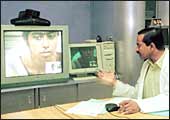 |
|
A click in time: A
doctor videoconferences with his patient
|
The way K. Ganapathy,
a neuro-surgeon and Senior Vice President, Apollo Telemedicine
Networking Foundation, a trust established by Apollo Hospitals
sees it, the case for telemedicine is based on economics. "The
government will need to create 750 hospitals, with 250 beds each,
at a cost of Rs 25,000 crore every year to meet World Health Organisation
stipulated standards of reach (of healthcare)," he says.
"Given our expertise in software and medicine, much can be
achieved through telemedicine." Apollo's 76 telemedicine
centres are trying to do just this. At Rs 600-700 a pop, the cost
is not exactly b-o-p material, but this should go down with volumes
and lower broadband costs, one reason BSNL's big-bang broadband
venture is important to the nation.
-Nitya Varadarajan
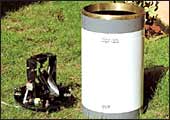 |
|
Rain-meter: Spatika's
electronic rain gauge
|
Rainy Day SMS
Spatika Varsha/The
intelligent (and low-cost) rain gauge
In a uniquely
Indian irony, Indian agriculture, which is dependent on the monsoon,
is yet to adopt modern rainfall measuring technology. This, when
proponents of scientific agriculture insist that micro-climatic
management is the ideal way to optimise crop yields. Karnataka,
for instance, has 1,100 manual gauges, one for every 450 sq. km
(V.S. Prakash, the head of the state's drought monitoring cell
would like one every 40 sq. km). Then there are issues related
to the collection and accuracy of data.
Prakash's department, in association with
a clutch of NGOs, is trying out an electronic rain gauge developed
by a Bangalore-based company, Spatika Information Technologies,
that measures rainfall electronically, and then, using prevalent
GSM technology, sends the data as an SMS to a central server at
pre-programmed intervals. In terms of how this data can contribute
to better agricultural practices, such gauges would be priceless.
-Rahul Sachitanand
Rural Relief
ICICI Lombard/Insurance
against debt
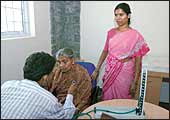 |
|
Immediate relief:
A policy-holder at narayana Hrudayalaya
|
Health and weather
are the two high-risk sectors that pull farmers into the debt
trap," says Smita Aggarwal, the head of insurer ICICI Lombard's
rural and agricultural business group. The lady is convinced that
insurance can help break the "vicious cycle perpetuated by
high-cost borrowings from money-lenders". And do so profitably.
That could explain the company's decision to ally with Biocon
Foundation, the charity arm of biotech firm Biocon, and Bangalore-based
hospital Narayana Hrudayalaya to launch a scheme that provides
policy-holders cash-free diagnosis and treatment at select hospitals,
and discounted medicines at BioCare Pharmacies, a Biocon offshoot.
That fits in with Biocon founder Kiran Mazumdar-Shaw's objective
of "providing affordable healthcare to 1 billion Indians".
All this costs Rs 180 a year (for one person), and Rs 480 for
a family of four. That's b-o-p.
-Rahul Sachitanand
 |
|
Over the hump: HLL
distributor Shanti Devi in Rajasthan's Neora Road village
is doing her bit for the cause of growth
|
Women Power
HLL's
Project Shakti/Reaching
Out
Project Shakti
is HLL's three-year old initiative to reach customers in villages
with a population less than 2,000 (there are over 6,00,000 such
in India and distributors largely ignore them because household
incomes rarely go beyond Rs 1,000 a month). "We had to re-look
at the consumer paradigm and the means for delivering the product,"
says Sharat Dhall, Business Head, Rural Ventures, HLL. "We
had to literally catalyse growth." That it did by identifying
women (they could gain easy access to households) who were part
of self-help groups (this provided them with the micro-capital
required) to operate as distributors. Now, Project Shakti has
reached a scale that makes it a successful example of b-o-p marketing.
It operates in 12 states, contributes 15 per cent to the company's
total rural sales in these states, and its 13,000 distribution
agents sell, on an average, products worth Rs 10,000 every month
(they earn Rs 800 on this).
-Priya Srinivasan
Hand-held Intelligence
Pico Peta/The
Simputer
 |
|
Guiding light: The
simputer pioneered low-cost computing
|
Four years after
it was developed by four professors from IISC, Bangalore, the
Simputer, a universal access device, is available in the market
at prices between Rs 10,000 and Rs 20,000 (as the Amida Simputer,
manufactured by public sector firm Bharat Electronics Limited).
Swami Manohar, CEO, Pico Peta, the company that owns the Simputer
franchise now, believes it is an "appropriate computing device
for most of India and not a replacement for a pc", a reference
to the fact that most people who buy a pc use only a fraction
of its abilities. Manohar speaks of aggressive nation-wide marketing
plans, but fact is, low-cost mobile telephones and low-cost computers
(they have even broken the Rs 10,000 barrier) may have already
stolen much of the Simputer's thunder. However, the Simputer,
and Pico Peta remain b-o-p pioneers.
-Supriya Shrinate
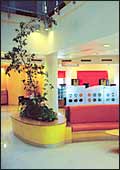 |
|
Budget hotel? Well,
IndiOne doesn't quite look like one
|
Travelling Salesman's
Solution
Indian Hotels (IndiOne)/Rooms at
Rs 850 a night
Budget hotels
bring to mind stained sheets, dingy restaurants, drunk salesmen
and poor service. So, when Indian Hotels decided to get off its
lofty perch (high-end rooms costing upwards of Rs 5,000 targeted
at the top five per cent of customers) and address the chunk (the
remaining 95 per cent of the market), it junked the classification:
budget became smart basics. The tariff remained strictly 'budget'
(Rs 850), though. Now, buoyed by the success of its first IndiOne
hotel in Bangalore-it opened for business last year and has an
occupancy rate of around 85 per cent-it is opening 10 more in
cities such as Thiruvananthapuram, Bhubaneshwar, Varanasi and
Durgapur. "No national chain has tapped the (budget segment)
opportunity," says Sheila Nair, coo, Roots Corporation, a
wholly-owned subsidiary of Indian Hotels that manages the IndiOne
initiative. The hotel has been configured for travelling pros
(think ATMs and Wi-Fi), focusses on weeding out non-revenue generators
(room service, corridors and banquet halls) and follows the self-service
model that, according to Nair, "makes people want to conform
to the offering".
-Priya Srinivasan
Affordable Bundle
Tata Indicom/Broadband access plus
device
 |
|
Access for all: Tata
Indicom's personal internet communicator
|
Broadband is
a commodity. And the cost of the access device, the biggest hurdle
to universal connectivity. "We are clearly in a position
to offer broadband connectivity, but what was holding us back
was the cost of the access device," explains Sashi Kalathil,
coo, Tata Indicom. Tata Indicom opted for a bundled offering;
its choice of device was unique. While most other telcos have
gone in for PCs, it opted for a no-frills internet access device
powered by AMD whose total cost (including monitor) is a mere
Rs 14,000. Tata Indicom sells it for an upfront payment of Rs
5,000 and charges between Rs 500 and Rs 1,000 a month towards
payback, the cost of broadband and maintenance. Now, the company
has a slew of value-added plans on the drawing board, including
a fairly revolutionary one involving software that resides on
a central server and can be paid for on a per-use basis.
-Priya Srinivasan
 |
|
Click for money: ICICI
Bank's low cost rural ATM
|
Rural Teller
ICICI Bank/An ATM for rural areas
ICICI bank has
a vision for rural India, one that revolves around Rs 2,00,000
crore in assets and 200 micro-finance partners servicing a million
customers each. One touchpoint the company will depend on is a
low-cost internet-based automated teller machine (ATM), developed
in association with IIT Chennai. The ATM, set for an imminent
rollout, incorporates the ability to handle used currency notes,
crucial given that the transaction value in the rural areas is
too miniscule to justify transportation costs of cash to the ATMs
(transaction value being anywhere between a tenth to a twentieth
of that in cities). It also costs far less than the ATMs that
proliferate the cityscape. "The cheapest ATMs in the city
cost Rs 3-3.5 lakh each, the rural ATM will cost a fraction of
this," says Nachiket Mor, ED, ICICI Bank. "The idea
is to bring financial services to every individual."
-Priya Srinivasan
Three-wheel Drive
Sriram Transport and Dewan Housing Finance/Loans
for lower income classes
 |
|
The Sriram secret:
Every tempo is micro-entrepreneur
|
The three-wheeled
tempo is the preferred carrier of goods for a host of Indian micro-entrepreneurs.
Sriram Transport, a Chennai-based financial services firm, saw
in this humble vehicle a source of self-employment for thousands
of people. And so, the company started financing such vehicles
a few months ago. "Warehouses in major metros will be moved
to the outskirts, and three-wheelers will be used more and more
to transport goods," says R. Sridhar, MD, Sriram Transport.
Another company that is tapping low-value loan requirements is
Dewan Housing Finance. Almost 95 per cent of its customers earn
less than Rs 20,000 a month (the company still has the lowest
proportion of bad loans in the business) and MD Kapil Wadhwa says
incremental disbursements are growing at 40 per cent a year. No
wonder IFC and ADB are funding its foray into smaller towns.
-Priya Srinivasan
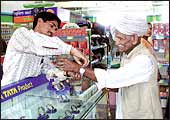 |
|
Selling@eChoupal:
Also a rural retail outlet
|
Rural Reach
ITC e-Choupal/Game Changer
In June 2000,
ITC launched its first e-Choupal. Today, there are 5,050 such
covering 31,000 villages and three million farmers. And six months
ago, the company launched its first Choupal Sagar, a rural hypermart.
Already some 70 companies ride the choupal infrastructure, and
Rs 50 crore worth of products are sold through it. "The idea
was to first increase the size of the rural wallet, then garner
a larger share of it," says S. Sivakumar, Chief Executive,
ITC International Business Division.
-E. Kumar Sharma
Direct Selling
DCM Shriram's Hariyali/A logical
extension
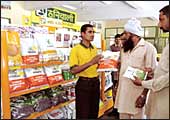 |
|
A Hariyali outlet:
It's the same customer
|
For a company
into businesses such as fertiliser and sugar, rural retail makes
great sense. That is why DCM Shriram Consolidated (DSCL) launched
Hariyali Kisan Bazar stores. Today there are 16 of these (each
is 7,000-10,000 sq. ft.) across up, Punjab and Rajasthan-the number
will double by 2006-stocking seeds, fertilisers, farm-fuel and
farm-equipment. "We focus on providing the right product
at the right time at the right quality and the right price,"
says Ajay S. Shriram, Chairman, DSCL.
-Supriya Shrinate
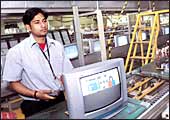 |
|
The right product:
Low-end TVs at LG's Noida plant
|
Durable Play
LG and Electrolux/Rural market
campaigners
The efforts
of LG to tap non-urban markets has been extensively chronicled.
Smart distribution and the strategy of picking frills-free products
for smaller towns helped it grow its revenues from Rs 3,315 crore
in 2002 to Rs 6,500 crore in 2004 (2005 target: Rs 9,000 crore);
almost 65 per cent of this comes from Class B and C towns. "We
will be more aggressive in the semi-urban and rural markets that
should grow at a rate of 40 per cent," says K.R. Kim, MD,
LG Electronics India. Swedish durable major Electrolux has jumped
into the fray too with its frills-free products like a refrigerator
with a 12-hour battery back up priced at Rs 10,900.
-Supriya Shrinate
Really Personal Computing
Xenitis & HCL Infosystems/Low-cost
PC makers
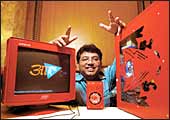 |
|
Xenitis' Nair: The
Amar PC may look classy but it is really cheap
|
It is called
Amar PC in West Bengal, Aamchi PC in Mumbai and Apna PC in Delhi.
And prices, including a colour monitor start at Rs 9,900. Founded
by childhood friends Santanu Ghosh and Tathagata Dutta, the 'personal'
computers from Xenitis Group have stormed every market where they
have been launched. "We want the computer to reach the masses,"
says D.N. Nair, CEO, Xenitis. According to it research and consulting
firm Gartner, India is the fastest growing pc market in the Asia
Pacific region; by 2008, says Sameer Kochhar, CEO, Skotch, an
it consultancy, "it will be a 10 million units a year market".
Xenitis, which forged a joint venture with Chinese firm Unitek
to manufacture PCs, will close this year with Rs 160 crore in
sales. Established players have not been lax in launching low-cost
PCs either. HCL Infosystems has one priced at Rs 12,990. "We
are looking at the low-end segment because it is the fastest growing,"
says Ajai Chowdhry, CEO, HCL Infosystems.
-Amanpreet Singh and Supriya
Shrinate
STRENGTH IN NUMBERS
"If we take nine countries-China,
India, Brazil, Mexico, Russia, Indonesia, Turkey, South Africa
and Thailand-collectively they are home to about 3 billion people
representing 70 per cent of the developing world population. In
PPP terms this group's GDP is $12.5 trillion.... It is larger
than the GDP of Japan, Germany, France, the UK and Italy combined.
This is not a market to be ignored."
C.K. Prahalad,
The Fortune At The Bottom Of
The Pyramid
 There
are four billion people across the world in the bottom layer of
the consuming pyramid. Each of these has a purchasing power (normalised
for parity) of $1,500 a year (Rs 66,000). In India, this segment
includes people who earn less than $2 (Rs 88) a day; they are
usually completely ignored by most companies. There
are four billion people across the world in the bottom layer of
the consuming pyramid. Each of these has a purchasing power (normalised
for parity) of $1,500 a year (Rs 66,000). In India, this segment
includes people who earn less than $2 (Rs 88) a day; they are
usually completely ignored by most companies.
That's surprising; the market at the bottom
of the pyramid in India is not something that can be ignored.
The 500 million people who live in over 600,000 villages are ideal
targets for fast moving consumer goods and micro-finance, just
as India's 700 million rural residents are for insurance. In value
terms, there is a Rs 25,000-crore market for telemedicine for
the taking and just one company planning a major micro-finance
foray is looking at a potential asset base of Rs 2,00,000 crore.
A few rungs up the pyramid, some 65 million households are ready
for broadband access and 150 million, for desktop PCs. And there
is a market worth Rs 14,000 crore per year there for the taking
for consumer durable makers willing to offer products at the right
price.
For companies, all these markets are within
reach and they aren't. The distance between the middle reaches
of the pyramid and its nether regions can be bridged only through
innovation. How, for instance, can one sell a PC for Rs 5,000
and still make money? For, make no mistake, making money is an
integral part of the game (charity isn't sustainable, you see).
To answer that question, curious as it may sound, the solution
may involve adopting a model where all software and storage would
be on a central server. This is a concept entrepreneurs such as
Rajesh Jain, the man who famously sold his dotcoms to Sify for
Rs 500 crore in 1999, are exploring. Tata Indicom is tweaking
the concept a trifle with an access plus broadband offering (with
the promise of software-on-a-server to come) in 40 cities. The
clear message? Flip the premise. This is a model that works across
sectors (as some of the examples on the previous pages show).
Meanwhile, the country's largest consumer
goods company, HLL, has seen an opportunity in the deplorable
state of drinking water in India. The result is a water purifier
branded Pureit that involves a capital cost of Rs 1,500, a recharge
cost of Rs 250 every 1,500 litres, and a running cost of Re 1
for six litres. At the consumer end, the way these costs can be
split between households and how the purifier can become a shared
resource is limited only by imagination.
It is not just large companies, even unorganised
players are beginning to get a hang of this game. Remember the
neighbourhood video-cassette library chap who ran a small business
in the 80s? Guess what he and others of his ilk are doing today?
You will probably run into them if you are looking at some very
inexpensive options to upgrade your mobile phone. They are innovators
of sorts with the ability to take the phone apart and refurbish
it at rates that a dealer cannot dream of doing. It's a sub culture
of mobile fanatics, if you will, and more importantly, it stars
trend-setters in terms of third party innovation and entrepreneurship.
Still not convinced it's time to shed the
developed market view of the world and consumers?
Look at what is happening in the area of
micro finance, even housing finance for the middle and lower income
group. Almost all entry-level consumers in this market come from
the unorganised sector where interest rates are astronomically
high. In housing finance alone it can be as high as 25 per cent
as opposed to 7.5-9 per cent in the organised sector. Prahalad
has an interesting term to explain what's happening here; he believes
consumers are paying 'poverty premium' or 'poverty penalty'. In
markets such as these, the organised sector can charge a risk
premium and therefore a higher interest rate (which is still not
likely to exceed 10 per cent); it can also restore dignity to
consumers who have hitherto been marginalised.
In fact, all it takes to tap that vast, tradition
defying, teeming market of a half a billion or more people is
a rethink. Then, innovation has always been the bugbear of Indian
enterprise. Still, if the case studies listed here are any indication,
some Indian companies seem to be innovating in tandem to create
the next inflection point for the Indian economy.
Priya Srinivasan
|

















 There
are four billion people across the world in the bottom layer of
the consuming pyramid. Each of these has a purchasing power (normalised
for parity) of $1,500 a year (Rs 66,000). In India, this segment
includes people who earn less than $2 (Rs 88) a day; they are
usually completely ignored by most companies.
There
are four billion people across the world in the bottom layer of
the consuming pyramid. Each of these has a purchasing power (normalised
for parity) of $1,500 a year (Rs 66,000). In India, this segment
includes people who earn less than $2 (Rs 88) a day; they are
usually completely ignored by most companies.